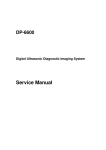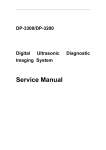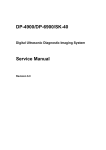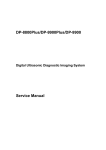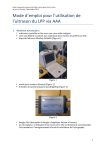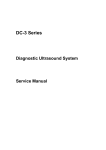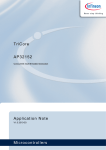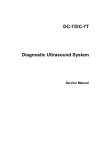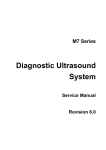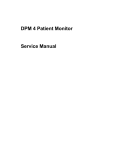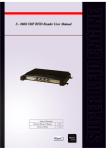Download Service Manual
Transcript
DP-6600 Digital Ultrasonic Diagnostic Imaging System Service Manual © 2005-2006 Shenzhen Mindray Bio-medical Electronics Co., Ltd. All rights Reserved. Product Information: Product Name: Digital Ultrasonic Diagnostic Imaging System Model: DP-6600 Issued Date of this manual: 2006-10 Version: 1.1 Digital Ultrasonic Diagnostic Imaging System Service Manual(V1.1) I Intellectual Property Statement SHENZHEN MINDRAY BIO-MEDICAL ELECTRONICS CO., LTD. (hereinafter called Mindray) owns the intellectual property rights to this Mindray product and this manual. This manual may refer to information protected by copyrights or patents and does not convey any license under the patent rights of Mindray, nor the rights of others. Mindray does not assume any liability arising out of any infringements of patents or other rights of third parties. Mindray intends to maintain the contents of this manual as confidential information. Disclosure of the information in this manual in any manner without the written permission of Mindray is strictly forbidden. Release, amendment, reproduction, distribution, rent, adaptation and translation of this manual in any manner whatsoever without the written permission of Mindray is strictly forbidden. , , , , are the registered trademarks or trademarks owned by Mindray in China and other countries. All other trademarks that appear in this manual are used only for editorial purposes without the intention of improperly using them. They are the property of their respective owners. II Digital Ultrasonic Diagnostic Imaging System Service Manual(V1.1) Responsibility on the Manufacturer Party Contents of this manual are subject to changes without prior notice. All information contained in this manual is believed to be correct. Mindray shall not be liable for errors contained herein nor for incidental or consequential damages in connection with the furnishing, performance, or use of this manual. Mindray is responsible for safety, reliability and performance of this product only in the condition that: • all installation operations, expansions, changes, modifications and repairs of this product are conducted by Mindray authorized personnel; • the electrical installation of the relevant room complies with the applicable national and local requirements; • the product is used in accordance with the instructions for use. WARNING: It is important for the hospital or organization that employs this equipment to carry out a reasonable service/maintenance plan. Neglect of this may result in machine breakdown or injury of human health. Digital Ultrasonic Diagnostic Imaging System Service Manual(V1.1) III Warranty THIS WARRANTY IS EXCLUSIVE AND IS IN LIEU OF ALL OTHER WARRANTIES, EXPRESSED OR IMPLIED, INCLUDING WARRANTIES OF MERCHANTABILITY OR FITNESS FOR ANY PARTICULAR PURPOSE. Exemptions Mindray's obligation or liability under this warranty does not include any transportation or other charges or liability for direct, indirect or consequential damages or delay resulting from the improper use or application of the product or the use of parts or accessories not approved by Mindray or repairs by people other than Mindray authorized personnel. This warranty shall not extend to: any Mindray product which has been subjected to misuse, negligence or accident; any Mindray product from which Mindray's original serial number tag or product identification markings have been altered or removed; any product of any other manufacturer. IV Digital Ultrasonic Diagnostic Imaging System Service Manual(V1.1) Return Policy Return Procedure In the event that it becomes necessary to return this product or part of this product to Mindray, the following procedure should be followed: 1. Obtain return authorization: Contact the Mindray Service Department and obtain a Customer Service Authorization (Mindray) number. The Mindray number must appear on the outside of the shipping container. Returned shipments will not be accepted if the Mindray number is not clearly visible. Please provide the model number, serial number, and a brief description of the reason for return. 2. Freight policy: The customer is responsible for freight charges when this product is shipped to Mindray for service (this includes customs charges). 3. Return address: Please send the part(s) or equipment to the address offered by Customer Service department Company Contact Manufacturer: Address: Shenzhen Mindray Bio-Medical Electronics Co., Ltd. Mindray Building, Keji 12th Road South, Hi-tech Industrial Park, Nanshan, Shenzhen,518057, P.R.China Phone: +86 755 26582479 26582888 Fax: +86 755 26582934 26582500 EC-Representative: Address: Phone: Fax: Shanghai International Holding Corp. GmbH(Europe) Eiffestrasse 80, 20537 Hamburg Germany 0049-40-2513175 0049-40-255726 Digital Ultrasonic Diagnostic Imaging System Service Manual(V1.1) V Safety Precautions 1. Meaning of Signal Words In this operation manual, the signal words DANGER, WARNING, CAUTION and NOTE are used regarding safety and other important instructions. The signal words and their meanings are defined as follows. Please understand their meanings clearly before reading this manual. Signal word Meaning DANGER Indicates an imminently hazardous situation which, if not avoided, will result in death or serious injury. WARNING Indicates a potentially hazardous situation which, if not avoided, could result in death or serious injury. CAUTION Indicates a potentially hazardous situation which, if not avoided, may result in minor or moderate injury. NOTE Indicates a potentially hazardous situation which, if not avoided, may result in property damage. 2. Meaning of Safety Symbols Symbol Description Type-BF applied part NOTE :All ultrasound transducers can be connected to this system are Type-BF applied part. "Attention" indicates the points requiring attention. Be sure to read the operation manual concerning these points before using the equipment. VI Digital Ultrasonic Diagnostic Imaging System Service Manual(V1.1) 3. Safety Precautions Please observe the following precautions to ensure patient and operator safety when using this system. CAUTION: 1. Display the most suitable image and select the most suitable measurement mode for the intended measurement. The results must be determined by a specialist. 2. The basic measurement results are not displayed in the exam report. 3. Be sure to perform measurement within images. If the area is outside the image, incorrect diagnosis may result. 4. The detailed precautions for each measurement are described in the corresponding section. Read and understand these precautions before performing the measurement. 5. Data in temporary storage areas, such as the CINE memory, is deleted when the power supply is turned OFF or when the Patient switch is pressed. Such data may also occasionally be deleted due to accidents. To minimize the possibility of reexamination being required as a result of unintended data deletion, back up the required images on external storage media. 6. Refer to the Operation Manual (Fundamentals) for precautions regarding the use of this system. Digital Ultrasonic Diagnostic Imaging System Service Manual(V1.1) VII Contents Contents CHAPTER1 GENERAL DESCRIPTION................................................................ 1-1 1.1 INTRODUCTION.............................................................................................................. 1-1 1.2 PREPARATION FOR REPAIR........................................................................................... 1-3 1.3 SCHEMATIC DIAGRAM ................................................................................................... 1-5 CHAPTER2 STRUCTURE OF THE COMPLETE MACHINE & DISASSEMBLY.. 2-1 2.1 STRUCTURE OF THE COMPLETE MACHINE .................................................................. 2-1 2.1.1 The appearance view of the main unit .................................................................... 2-1 2.1.2 The exploded drawing of the complete machine ................................................... 2-1 2.1.3 The keyboard assembly ............................................................................................ 2-3 2.1.4 The exploded drawing of CRT assembly ................................................................ 2-4 2.1.5 The power assembly.................................................................................................. 2-5 2.2 DISASSEMBLY ............................................................................................................... 2-6 2.2.1 Disassembly of the rear cover .................................................................................. 2-6 2.2.2 Disassembly of the cabinet tail board...................................................................... 2-7 2.2.3 Disassembly of the cabinet rear cover .................................................................... 2-8 2.2.4 Disassembly of the power board.............................................................................. 2-9 2.2.5 Disassembly of the main board and the transducer board ................................2-10 2.2.6 Disassembly of CRT, CRT adjustment board and the connection board of the main unit ................................................................................................................... 2-13 2.2.7 Disassembly of CRT screen filter........................................................................... 2-16 2.2.8 Disassembly of the keyboard, trackball and buzzer............................................2-16 2.2.9 Disassembly of the fan ............................................................................................ 2-20 2.2.10 Remove USB extension wire.................................................................................. 2-20 CHAPTER3 DESCRIPTION OF THE PRINCIPLE................................................ 3-1 3.1 THE PRINCIPLE OF THE HARDWARE ............................................................................ 3-1 3.1.1 The power board ........................................................................................................ 3-1 3.1.2 The connection board ................................................................................................ 3-5 3.1.3 The transducer board .............................................................................................. 3-10 3.1.4 The main board......................................................................................................... 3-11 3.1.5 The keyboard ............................................................................................................ 3-15 3.1.6 CRT display ............................................................................................................... 3-16 3.1.7 Field tuning after replacing the board.................................................................... 3-16 3.2 PRINCIPLE OF THE SOFTWARE ...................................................................................3-17 Digital Ultrasonic Diagnostic Imaging System Service Manual(V1.1) 1 Contents 3.2.1 Features and functions of the real-time operating system .................................3-17 3.2.2 Description of the system software........................................................................ 3-18 3.2.3 Software upgrading procedure ............................................................................... 3-20 CHAPTER4 4.1 SYSTEM START-UP ......................................................................... 4-1 SYSTEM START-UP ....................................................................................................... 4-1 CHAPTER5 TROUBLESHOOTING ...................................................................... 5-1 5.1 BLACK SCREEN............................................................................................................. 5-1 5.2 NO RESPONSE FROM THE KEYBOARD ......................................................................... 5-1 5.3 NO ECHO SIGNAL IN IMAGE AREA ................................................................................ 5-2 5.4 BLACK AREA IN THE IMAGE(BLACK STRIP)............................................................. 5-3 5.5 IMAGE INTERFERENCE .................................................................................................. 5-3 5.6 BACK-END CIRCUITS FAULT ......................................................................................... 5-4 5.7 OTHER FAULTS ............................................................................................................. 5-4 CHAPTER6 MAINTENANCE AND CLEANING.................................................... 6-1 6.1 MAINTENANCE TO BE PERFORMED BY USER.............................................................. 6-1 6.1.1 Cleaning the system .................................................................................................. 6-1 6.1.2 Creating a backup copy of the system hard disk................................................... 6-2 6.2 MAINTENANCE TO BE PERFORMED BY SERVICE PERSONNEL ................................... 6-2 2 Digital Ultrasonic Diagnostic Imaging System Service Manual(V1.1) General Description Chapter1 General Description 1.1 Introduction DP-6600 is a portable digital diagnostic ultrasound system, which features black & white imaging. 1. Front view Power indicator Air inlet Figure 1-1 Front view 2. Rear view Digital Ultrasonic Diagnostic Imaging System Service Manual(V1.1) 1-1 General Description Handle Gel cup holder Transducer holder CRT vent grounding pole Power inlet Transducer cable hook Power switch Winding rack Main unit vent ain unit vent Network interface Printer interface Video interface Figure 1-2 Rear view 3. Left view USB interface Figure 1-3 Left view 4. Right view 1-2 Digital Ultrasonic Diagnostic Imaging System Service Manual(V1.1) General Description Transducer socket Figure 1-4 Right view 5. Elevation view(with the keyboard unfolded) Figure 1-5 Elevation view(with the keyboard unfolded) 1.2 Preparation for Repair The needed tools and measurement devices are shown as followed: Table 1-1 Tools and Devices for Repair Digital Ultrasonic Diagnostic Imaging System Service Manual(V1.1) 1-3 General Description Tool Model Manufacturer Screwdriver (various sizes and Spec./Standard Unspecified types) Flat-headed screwdriver (large) Unspecified Wire nippers Unspecified Needle nose pliers Unspecified Diagonal pliers Unspecified Soldering iron and stand Unspecified Desoldering tool Unspecified Wrench set Unspecified Adjustable wrench Unspecified Tweezers Unspecified Hammer Unspecified Metric Allen wrench set Unspecified File (various types) Unspecified Cutter Unspecified Table 1-2 Consumable Material Consumable Material Model Insulation tape Hishilite tube, Manufacturer Specification/Standard Unspecified Empire tube Unspecified (various types) Wires (various types) Unspecified Screws, nuts, washers (various Unspecified types) Solder Paper file (various types) Ethanol for cleaning and disinfection 1-4 Digital Ultrasonic Diagnostic Imaging System Service Manual(V1.1) General Description 1.3 Schematic Diagram Figure 1-6 Schematic Diagram Digital Ultrasonic Diagnostic Imaging System Service Manual(V1.1) 1-5 Structure of the Complete Machine & Disassembly Chapter2 Structure of the Complete Machine & Disassembly 2.1 Structure of the Complete Machine 2.1.1 The appearance view of the main unit 1 1.Main unit 2300-30-29157 Figure 2-1 The appearance view of the main unit 2.1.2 The exploded drawing of the complete machine 2.1.2.1 The exploded drawing of the complete machine 7 8 9 Refer to the figure below 2 3 4 5 6 10 11 12 Refer to the figure below 13 14 1 20 19 18 17 Refer to the figure below 15 16 Figure 2-2 2-1 The exploded drawing of the complete machine Digital Ultrasonic Diagnostic Imaging System Service Manual(V1.1) Structure of the Complete Machine & Disassembly 2.1.2.2 Parts of each assembly 1. CRT knob 2300-20-29084 2. screen filter fixing buckle 9901-20-23950 3. screen filter 2102-20-16994 4. keyboard hook 2300-20-29092 5. front cover 2300-20-29078 6. 2300-20-29091 keyboard protective pad 7. handle rubber cap A 2300-20-29089 8. handle rubber cap B 2300-20-29090 9. handle 2300-20-29081 10. transducer holder 2300-20-29082 11. rear cover 2300-20-29079 12. transducer cable hook 2102-30-16949 13. winding rack 2300-20-29083 14. winding rack rubber cap 2300-20-29088 15. hook holder 2300-20-29085 16. bottom rubber pad 2300-20-29087 17. bottom plate 2300-20-29080 18. USB cable 2300-20-29138 19. conductive cloth 9901-10-23920 20. USB compressor 2300-20-29106 Digital Ultrasonic Diagnostic Imaging System Service Manual(V1.1) 2-2 Structure of the Complete Machine & Disassembly 2.1.3 The keyboard assembly 2.1.3.1 The exploded drawing (1) of the keyboard assembly 3 4 5 6 7 1 9 10 11 8 2 Figure 2-3 The exploded drawing (1) of the keyboard assembly 2.1.3.2 Parts of the keyboard assembly (1) 1. keyboard upper cover assembly 2300-30-29156 2. keyboard lower cover assembly 2300-30-29155 3. keyboard knob C 2300-20-29073 4. keyboard silicon cap 2300-20-29076 5. keyboard DIP switch 2300-20-29074 6. keyboard knob B 2300-20-29072 7. keyboard knob A 2300-20-29071 8. hollow shaft 2300-20-29067 9. position limiter 2300-20-29066 10. compressing spring 2300-20-29065 11. keyboard buckle 2300-20-29064 2-3 Digital Ultrasonic Diagnostic Imaging System Service Manual(V1.1) Structure of the Complete Machine & Disassembly 2.1.3.3 The exploded drawing (2) of the keyboard assembly 1 2 3 6 4 5 Figure 2-4 The exploded drawing (2) of the keyboard assembly 2.1.3.4 Parts of the keyboard assembly (2) 1. keyboard upper cover 2300-30-29156 2. dust plate 2300-20-29075 3. buzzer 2300-21-29142 4. silicon key 2300-20-29060 5. keyboard PCB board 2300-20-29057 6. trackball 0000-10-10893 2.1.4 The exploded drawing of CRT assembly 2.1.4.1 The exploded drawing of CRT assembly 1 2 Figure 2-5 3 4 5 The exploded drawing of CRT assembly Digital Ultrasonic Diagnostic Imaging System Service Manual(V1.1) 2-4 Structure of the Complete Machine & Disassembly 2.1.4.2 Parts of CRT assembly 1.CRT assembly 2300-21-29149 2. CRT frame 2300-20-29094 3.CRT insulation pad 2300-20-29095 4. handle frame 2 2300-20-29108 5.guard plate 2300-20-29109 2.1.5 The power assembly 2.1.5.1 The exploded drawing of the power assembly 7 8 1 2 3 4 5 6 9 10 11 12 13 14 15 16 17 1819 24 25 26 27 28 29 20 21 22 23 Figure 2-6 The exploded drawing of the power assembly 2.1.5.2 Parts of the power assembly 1. Power box upper cover 2300-20-29194 2. Fan connection wire 3. Power board 2300-30-29059 4. Power board support 2300-20-29141 2300-20-29098 5. Power box shielding pad 2300-20-29202 6. Power box lower cover 2300-20-29195 7.Connection board 2300-30-29053 8. Main unit cabinet 2300-20-29096 9. Plastic slot M90-000115--- 10. Right wind shield 2300-20-29113 11. Cabinet rear cover 2300-20-29104 13.Left wind shield 2300-20-29107 14. Fan 2300-20-29143 15. Fan pad 2300-20-29099 16.Cabinet tail board 2300-20-29105 2-5 12.Power connection wire 2300-20-29140 Digital Ultrasonic Diagnostic Imaging System Service Manual(V1.1) Structure of the Complete Machine & Disassembly 17. Grounding pole 0509-20-00098 18.Power socket 19. Power switch 2100-10-07943 20. Main board connector 2300-20-29208 21.Main board 2300-30-29051 22.Main board support 2300-20-29110 23. Conductive cloth 9901-10-23920 24.Transducer board shield cover 2300-20-29198 25.Transducer board 2300-30-29055 26. Transducer socket fixed plate 2300-20-29101 27. Shield spring A 2102-20-16918 28. Shield spring B 2102-20-17113 29. Transducer socket fastener 2300-20-29199 2300-21-29147 2.2 Disassembly 2.2.1 Disassembly of the rear cover 1. Removing the transducer cable hook (1) (2) Figure 2-7 Disassembly of the rear cover A、 Turn the transducer cable hook clockwise to the end; B、 Take out the transducer cable hook upward. 2. Removing the handle and winding rack Digital Ultrasonic Diagnostic Imaging System Service Manual(V1.1) 2-6 Structure of the Complete Machine & Disassembly M4x16 Screw Handle rubber Handle cap A rubber cap B M4x12 Screw Winding rack rubber cap Figure 2-8 Removing the handle and winding rack 3. A. Pull out the handle rubber cap A&B and the winding rack rubber cap; B. Remove the two M4x16 fixing screws, and then take out the handle C. Remove the two M4x12 fixing screws, and then take out the winding rack Removing the rear cover (1) Figure 2-9 Removing the rear cover A. lift the tail of the rear cover forcibly; B. Move the rear cover backwards to remove it. 2.2.2 Disassembly of the cabinet tail board 2-7 1. Remove the rear cover; 2. Disconnect the fan connector of the tail board; 3. Remove 8 M3X6 screws fixing the tail board and 2 M3X6 screws fixing the main Digital Ultrasonic Diagnostic Imaging System Service Manual(V1.1) Structure of the Complete Machine & Disassembly board; 4. Disconnect the power wire connector and move the tail board backward to take it out. power wire connector Fan connector 2 Fixing screws of the main board(M3X6) 8 Fixing screws of the tail board(M3X6) Figure 2-10 Disassembly of the cabinet tail board 2.2.3 Disassembly of the cabinet rear cover 1. Remove the assembly of the cabinet tail board; 2. Disconnect the fan connector of the rear cover; 3. Remove 9 M3X6 screws fixing the rear cover and take out the rear cover. Fan connector 9 fixing screws(M3X6) Figure 2-11 Disassembly of the cabinet rear cover Digital Ultrasonic Diagnostic Imaging System Service Manual(V1.1) 2-8 Structure of the Complete Machine & Disassembly 2.2.4 Disassembly of the power board 1. Remove the assembly of cabinet rear cover; 2. Pull out the assemble of the power board; le semb e as rd h t out boa Pull e power h of t Figure 2-12 Disassembly of the power board 3. Remove 6 M3X6 screws fixing the power box upper cover, and open the upper cover; 4. Disconnect the fan connector of the power board; 6 screws fixing the upper cover(M3X6) Fan connector Figure 2-13 Disconnecting the fan connector 5. 2-9 Remove 7 M3X8 screws fixing the power board and take out the power board; Digital Ultrasonic Diagnostic Imaging System Service Manual(V1.1) Structure of the Complete Machine & Disassembly 7 M3X8 screws fixing the power board Power board Power board shielding pad Power board lower cover Figure2-14 Disassembly of the power board 2.2.5 Disassembly of the main board and the transducer board 1. Disassemble the rear cover to take out the assemblies of the tail board and the back board; 2. Remove 3 M3X8 screws fixing the holder of the transducer cable hook and take out the holder; 3 Fixing screws (M3X8) Holder USB wire connector Figure 0-15 Remove the holder of the transducer cable hook 3. Remove the USB wire connector; Digital Ultrasonic Diagnostic Imaging System Service Manual(V1.1) 2-10 Structure of the Complete Machine & Disassembly 4. Remove 8 M3X6 screws fixing the holder and one M3X6 screw fixing the main board; 8 M3X6 screws fixing the transducer socket Figure 0-16 Disassembly of the main board and the transducer board(1) Pu l bo l o ar ut d an the d th ass e e tr mbl an i sd es uc er Figure 0-17 Disassembly of the main board and the transducer board(2) 5. 2-11 Pull out the assemblies of the main board and the transducer board backward; Digital Ultrasonic Diagnostic Imaging System Service Manual(V1.1) Structure of the Complete Machine & Disassembly Pul boa l ou rd t t and he the asse tra mbli nsd es uce of r b the oar ma d b in ack war d Figure 0-18 Disassembly of the main board and the transducer board(3) 6. Remove 7 M3X6 screws connecting the assemblies of the main board and the transducer board, and disassemble the main board; 7 M3X6 connecting screws Figure 0-19 Disassembly of the main board and the transducer board(4) Digital Ultrasonic Diagnostic Imaging System Service Manual(V1.1) 2-12 Structure of the Complete Machine & Disassembly 7. Remove 8 M3X6 screws fixing the transducer board shield cover; 7 M3X6 screws fixing the transducer board shield cover Figure 0-20 Disassembly of the main board and the transducer board(5) 8. Remove 4 M3X6 screws fixing the connection board of the transducer socket, and remove the transducer board; 4 M3X6 screws fixing the connection board Figure 2-21 Disassembly of the main board and the transducer board(6) 2.2.6 Disassembly of CRT, CRT adjustment board and the connection board of the main unit 1. Disassemble the rear cover to take out the assemblies of the tail board and the back board; 2-13 Digital Ultrasonic Diagnostic Imaging System Service Manual(V1.1) Structure of the Complete Machine & Disassembly 2. Remove 4 PT4X14 screws fixing the front cover; 4 PT4X14 screws fixing the front cover Figure 2-22 Remove 4 PT4X14 screws fixing the front cover 3. Disconnect CRT signal cable, keyboard connection wire, CRT power wire and CRT adjustment board connector; CRT signal cable CRT power wire Keyboard connection wire CRT adjustment board connector Figure 2-23 Disconnect the connection wires Digital Ultrasonic Diagnostic Imaging System Service Manual(V1.1) 2-14 Structure of the Complete Machine & Disassembly 4. Remove 8 M3X8 screws fixing CRT assembly and take out CRT; 8 M3X8 screws fixing CRT assembly Figure 2-24 5. Remove CRT assembly Remove CRT adjustment knobs and 4 PT3X8 screws fixing CRT adjustment board, and then remove the CRT adjustment board; CRT adjustment knobs 4 PT3X8 screws fixing CRT adjustment board Figure 0-25 Remove CRT adjustment knobs 6. 2-15 Remove 8 M3X6 screws fixing the connection board of the main unit, and then Digital Ultrasonic Diagnostic Imaging System Service Manual(V1.1) Structure of the Complete Machine & Disassembly remove the connection board of the main unit. 8 M3X6 screws fixing the connection board Figure 0-26 Remove the connection board of the main unit 2.2.7 Disassembly of CRT screen filter 1. Slide the two screen filter buckles outward and pull them out; 2. Pull out the upper screen filter outward and uplift it, and then take it out. (3) (1) (1) (2) (4) (2) Figure 2-27 Disassembly of CRT screen filter 2.2.8 Disassembly of the keyboard, trackball and buzzer 1. Remove the two keyboard silicon caps, and then remove 2 M3×6 screws fixing the keyboard upper cover; Digital Ultrasonic Diagnostic Imaging System Service Manual(V1.1) 2-16 Structure of the Complete Machine & Disassembly Two keyboard silicon caps 2 M3x6 screws Figure 2-28 Remove the two keyboard silicon caps and two screws 2. Open the keyboard upper cover by hands forcibly at the positions of arrows; keyboard upper cover assembly keyboard lower cover assembly Figure 2-29 Disassembly of the keyboard upper cover 2-17 Digital Ultrasonic Diagnostic Imaging System Service Manual(V1.1) Structure of the Complete Machine & Disassembly 3. Disconnect the connection wire connector of the keyboard, and remove the keyboard upper cover; Keyboard connection wire Figure 2-30 Disassembly of the keyboard upper cover 4. Disconnect the connection wire connector of the trackball, remove 4 self-threading ST3x14 screws fixing the trackball, and remove the trackball; Connection wire of the trackball 4 self-threading screws Figure 0-31 Disassembly of the trackball Digital Ultrasonic Diagnostic Imaging System Service Manual(V1.1) 2-18 Structure of the Complete Machine & Disassembly 5. Pull out keyboard knobs A, B, C and 6 keyboard DIP switches; keyboard knob C 6 keyboard DIP switches keyboard knob D keyboard knob B keyboard knob A Figure 2-32 Remove the keyboard knobs and switches 6. Disconnect the connection wire connector of the buzzer, remove 14 ST3x8 screws fixing the keyboard, remove the silicon keys to take out keyboard PCB board, and remove 2 ST2x6 screws fixing the buzzer to take out the buzzer. ST3x8 screws(14) Keyboard Connection wire PCB of the buzzer Silicon keys 2 ST2x6screws buzzer Figure 2-33 Remove the buzzer 2-19 Digital Ultrasonic Diagnostic Imaging System Service Manual(V1.1) Structure of the Complete Machine & Disassembly 2.2.9 Disassembly of the fan 1. Remove the rear cover; 2. Disconnect the tail board fan connector and remove 4 M3X30 screws, and then remove the tail board fan; 4 M3X30 Screws fixing the fan Fan pad Fan Figure 2-34 Disassembly of the tail board fan 3. Disconnect the back board fan connector and remove 8 M3X30 screws, and then remove the back board fan. 8 M3X30 Screws i i h Fan Fan pads Figure 2-35 Disassembly of the back board fan 2.2.10 Remove USB extension wire 1. Disassemble the rear cover, the cabinet tail board assembly, the cabinet back board assembly and the front cover assembly; Digital Ultrasonic Diagnostic Imaging System Service Manual(V1.1) 2-20 Structure of the Complete Machine & Disassembly 2. Remove 7 PT3x8 screws fixing the cabinet bottom board, and remove the cabinet; 7 PT3x8 screw Figure 2-36 Disassemble the cabinet 3. Remove 2 PT3x 8 screws fixing USB compressor, and remove USB compressor, and then take out USB extension wire. PT3x8 screw USB compressor Figure 2-37 Remove USB extension wire 2-21 Digital Ultrasonic Diagnostic Imaging System Service Manual(V1.1) Description of the Principle Chapter3 Description of the Principle 3.1 The Principle of the Hardware 3.1.1 The power board 3.1.1.1 Description of the power board The power system is designed to supply power for the overall ultrasound diagnostic system, and it can supply nine static DC outputs, including the +5V ( D+5V and A+5V ) , -5V, +12V, +13.5V, +3.3V, +1.5V, +2.5V and program-controlled high voltage outputs. The performance specifications for each output are shown in Table 3-1. Table 3-1 the specifications for the power board outputs Item Rated Voltage Voltage Precision Rated Load (V) 1 A+5V 3A Mini mum Load Voltag e Adjust ment Rate Load Adjust ment Rate Ripple Noise Use (mVpk-pk) 0.5A Analog circuits/keyboard 2 D+5V 3.5A 1.0A 3 -5.0V 0.4A 20m <30mV Keyboard /USB Amplifier A 4 +13.5V 5 +12V ±5% 1.5A 0.3A 0.35A 100 mA 6 HV 50mA VGA <2% Fan /CMOS <5% <50mV 0 devices Transmission circuit 7 +3.3V 3.5A 0.2A 8 +2.5V 1.0A 0.2A 9 +1.5V 2.0A 0.2A Digital circuits <30mV Digital circuits Digital circuits 3.1.1.2 The basic principle The schematic diagram of the power board is shown in Figure 2-1. Digital Ultrasonic Diagnostic Imaging System Service Manual(V1.1) 3-1 Description of the Principle As shown in the figure, the power board is comprised of the input circuit, PFC front end, FORWARD converter and back stage DC-DC converter circuits. The AC input first goes through the EMI filter and surge suppression circuit, and then the BOOST APFC circuit to have the power factor corrected and to provide a stable 390V DC voltage to the FORWARD converter. The FORWARD converter provides 4 outputs, +5V, -5V, +13.5V and +24V. The 24V output serves as the input of the HV output of the power board. The +13.5V output passes two diodes to generate the +12V output of the power board. The +5V output serves two purposes: 1) to be divided into the A+5V and D+5V outputs of the power board; 2) to serve as the input to the back stage DC-DC converters to generate the +3.3V, +2.5V and +1.5V outputs of the power board. The PFC circuit adopts the TI UC3854 as the control chip and incorporates the BOOST converter. The main switching transistor and free wheeling diode used are the IR IRFPC60LC and the FAIRCHILD ISL9RL1560G2, whose parameters are 600V/16A and 600V/15A respectively. EMI FILTER & AC INPUT INRUSH LIMIT FORWARD CONVERTOR BOOST APFC STAGE LINEAR REGULATOR - 5V OCP/OVP MAGNETIC AMPLIFIER + 13 .5V OVP & OTP 2 +1 2V LINEAR REGULATOR BOOST CONVERTOR HV OCP/OVP 3 1 VOLTAGE CONVERTING PWM CONTROLLER HVC A+5 V +5 V D+5 V FEEDBACK PHOTOCOUPLER OCP & OVP BUCK CONVERTOR +3 .3 V LINEAR REGULATOR +2 .5 V BUCK CONVERTOR +1 .5 V Figure 3-1 the schematic diagram of the power board 3-2 Digital Ultrasonic Diagnostic Imaging System Service Manual(V1.1) Description of the Principle The FORWARD converter adopts the FUJITSU MB3769A as the control chip. The transformer T1 transforms the AC voltage into the DC voltage and isolates the former from the latter, making the system safe. The NEC 2SK2485 is used as the switching transistor, whose parameter is 900V/6A. The main feedback output of the FORWARD converter is +5V. The +13.5V output of the FORWARD converter is first stabilized by the magnetic amplifier and then serves as the +13.5V output of the power board. The -5V output of the FORWARD converter is first stabilized and then serves as the -5V output of the power board. The BOOST converter, using the ON-SEMI TL594 as the control chip, converts the 24V output of the FORWARD converter into the HV output of the power board. An analog signal that varies between 0 to 4V controls the HV output, the latter varying linearly with the change of the former. The BUCK converters, using the INTERSIL EL7566 as the control chips, are used to generate the +3.3V and +1.5V outputs of the power board. The +3.3V output is also passed to a linear stabilizer, which is composed of discrete devices, to generate the 2.5V output of the power board. The power board features the over-voltage protection for the PFC output, the over-temperature protection, the over-voltage /over-current /short-circuit protection for the +5V output, the over-voltage /over-current /short-circuit protection for the +13.5V output, the over-voltage /over-current /short-circuit protection for the HV output, and the short-circuit protection for all other outputs. Once the protections are tripped, the power board reacts as follows: 1. When the over-voltage protection for the PFC output, over-temperature protection or the over-voltage /over-current /short-circuit protection for the +5V output is tripped, the power board cuts off all the outputs and keeps them locked. Only after the AC input is cut off and the fault is cleared and the system is reset, does the system return to normal work; 2. When the over-voltage /over-current /short-circuit protection for the +13.5V output is tripped, both the +13.5V output and the HV output are cut off and remain locked. After the fault is cleared and all loads are disconnected from the +13.5V output, both the outputs will resume; 3. When the short-circuit protection for the +3.3V output is tripped, both the +3.3V output and the HV output are cut off. After the fault is cleared, both the outputs will resume; Digital Ultrasonic Diagnostic Imaging System Service Manual(V1.1) 3-3 Description of the Principle 4. When the over-voltage /over-current /short-circuit protection for the HV output, over-current /short-circuit protection for the -5V output, short-circuit protection for the +1.5V output, or the over-current /short-circuit protection for +2.5V output is tripped, the faulty output will be cut off independently without affecting any normal output. After the fault is cleared, all the outputs return to normal work automatically, except the HV output remains locked. 3.1.1.3 Maintenance of the power board Before tested, the power board should be connected as per Figure3-2. In the figure, the load A is a must, while the load B depends on situations. Under some conditions, for the purpose of easy repair, the load B is not allowed to exceed 0.1A, and it should be applied only when other outputs are minimum. 390V DCAC INPUT LOAD B POWER SUPPLY LOAD A (AT LEAST THREE MODULES) Figure 3-2 Connection schematic of the power board for testing Based on your own needs, you can connect the loads only to the +5V, +13.5V and HV outputs. For the purpose of easy adjustment, it is recommended that the adjustment starts with a load slightly greater than the minimum load, and the load can be increased according to practical situations during adjustment. After the power board is correctly connected, follow the flow chart indicated in Figure3-3 to find and fix the faults. 3-4 Digital Ultrasonic Diagnostic Imaging System Service Manual(V1.1) Description of the Principle switch on AC input. Y Is +5V output Y Is +13.5V output normal? normal? N Check if U3, Q4, T1 and R66 are normal. Y Y Is end voltage of Is +3.3V output C12 390Vdc? normal? Y N Check the OTP 检查 OTP、 及+5V 输 circuit and OCP, OVP circuit of 电路 +5V 出 OCP 和 OVP output. Y Check the OVP circuit of PFC output, C23, Y C24, R30 and feedback resistor, etc. N Check +13.5V circuit, especially the discrete devices L11, ZD5 and U7, etc. Is there a positive pulse voltage exceeding 2V for the anode of D15 or D16 at power-on instant? N Check +3.3V circuit, especially the discrete devices U16, C133, etc. Check and test other output circuits respectively N Is there a positive pulse exceeding 2V for the anode of D14 at power-on instant? N Check U1 and the components around it Y and L5, Q1, D2, etc. Does the maximum end voltage of C25 exceed 14.5V at power-on instant? N Check & replace D44, ZD1, U1, startup resistor, Q2, Q3 and fuse, etc. End. Figure 3-3 Trouble-shooting flow chart for the power board 3.1.2 The connection board The connection board is designed for connecting the main board, power board, keyboard and monitor. See Figure 3-4 for the connections. Digital Ultrasonic Diagnostic Imaging System Service Manual(V1.1) 3-5 Description of the Principle MainBoard Power Power Power Probe Board User Interface VGA UART +5V Connection Board UART +13.5V VGA Key Board Monitor Figure 3-4 Interconnection of the system The signals of the connection board are defined as follows: Table 0-2 Definition of the connection board signals Symbol Name Description NC Empty No connection GND Ground Ground, not specified as the analog or digital ground. PHV High voltage The HV output of the power board, ranging from +30V pulse to +140V. 13V5 +13.5V power The +13.5V output of the power board. 12V +12V power The +12V output of the power board. A+5 +5V analogue The A+5V output of the power board. digital The D+5V output of the power board. power D+5 +5V power 3V3 +3.3V power The +3.3V output of the power board. 2V5 +2.5V power The +2.5V output of the power board. 1V5 +1.5V power The +1.5V output of the power board. -5V -5V power The -5V output of the power board. HVC High The analog signal that goes from the main board to the voltage control power board to control the HV output and varies between 0 and 4V. RxDFromKB Receive data The 5V TTL serial signal from the keyboard to the main 3-6 Digital Ultrasonic Diagnostic Imaging System Service Manual(V1.1) Description of the Principle TxDToKB VS from keyboard board. Transmit data to The 5V TTL serial signal from the main board to the keyboard keyboard. VGA HS B vertical The 3.3V COMS signal from the main board to the synchronization monitor for VGA vertical synchronization. VGA horizontal The 3.3V COMS signal from the main board to the synchronization monitor for VGA horizontal synchronization. VGA The analog video signal from the main board to the video signal VGA port of the monitor, the maximum value up to 0.7V. A VME socket, the AMP AMP535043-4, is used for connecting the main board and the connection board. The main board is connected with the power board through the connection board, to obtain the powers PHV,-5V, A+5V,2.5V,1.5V,3.3V,12V, 13.5V and D+5V digital. The main board outputs an analog signal, HVC, to control the HV output of the power board. The serial signals RxDFromKB and TxDToKB are used for the communications between the main board and keyboard. The main board outputs the VGA signals HS, VS and B to the monitor. See Table 0-3 Definition of the interface signals between the main board and the connection board below: Table 0-4 Definition of the interface signals between the main board and the connection board A B C 1 PHV PHV PHV 2 NC NC NC 3 GND GND GND 4 -5V -5V -5V 5 GND GND GND 6 12V 12V 12V 7 GND GND GND 8 A+5 A+5 A+5 9 A+5 A+5 A+5 10 A+5 A+5 A+5 11 GND GND GND 12 HVC GND GND 13 GND GND GND 14 GND GND GND 15 2V5 2V5 2V5 Digital Ultrasonic Diagnostic Imaging System Service Manual(V1.1) 3-7 Description of the Principle 16 GND GND GND 17 1V5 1V5 1V5 18 1V5 1V5 1V5 19 GND GND GND 20 GND GND GND 21 3V3 3V3 3V3 22 3V3 3V3 3V3 23 GND GND GND 24 GND GND GND 25 13V5 13V5 13V5 26 VS GND GND 27 HS GND B 28 GND GND GND 29 TxDToKB GND RxDFromKB 30 GND GND GND 31 D+5 D+5 D+5 32 D+5 D+5 D+5 Another VME socket, also the AMP AMP535043-4, is used for connecting the power board and the connection board. See Table 0-4 for the definition of the interface signals: Table 0-4 Definition of the interface signals between the power board and the connection board A B C 1 PHV PHV PHV 2 NC NC NC 3 GND GND GND 4 -5V -5V -5V 5 GND GND GND 6 12V 12V 12V 7 GND GND GND 8 A+5 A+5 A+5 9 A+5 A+5 A+5 10 A+5 A+5 A+5 11 GND GND GND 12 HVC GND GND 13 GND GND GND 3-8 Digital Ultrasonic Diagnostic Imaging System Service Manual(V1.1) Description of the Principle 14 GND GND GND 15 2V5 2V5 2V5 16 GND GND GND 17 1V5 1V5 1V5 18 1V5 1V5 1V5 19 GND GND GND 20 GND GND GND 21 3V3 3V3 3V3 22 3V3 3V3 3V3 23 GND GND GND 24 GND GND GND 25 13V5 13V5 13V5 26 NC GND GND 27 NC GND NC 28 GND GND GND 29 NC GND NC 30 GND GND GND 31 D+5 D+5 D+5 32 D+5 D+5 D+5 The B8B-PH-K-S made by JST is used for connecting the keyboard and the connection board, and the interface signals between the two boards are defined in the table below. The serial communication signals between the keyboard and the main board are switched through the connection board, with TTL level and baud rate 38400bps; the +5V power of the keyboard is the D+5V output of the power board, and its current is 2A. Table 3-5 Definition of the interface signals between the keyboard and the connection board Position PIN1 PIN2 PIN3 PIN4 PIN5 PIN PIN7 PIN8 D+5 D+5 6 Signal RxDFromKB GND TxDToKB GND GND GN D Description Ground From keyboard main board to From main board to Ground +5V power keyboard The signals transmitted from the main board to the monitor are switched through the connection board. The horizontal synchronization signal HS and the vertical Digital Ultrasonic Diagnostic Imaging System Service Manual(V1.1) 3-9 Description of the Principle synchronization signal VS feature 3.3V CMOS, vertical scan frequency 60Hz, horizontal scan frequency 31.5KHz and non-interlaced scanning. The video signal is obtained from the B of RGB, and it is a monochromatic signal that features over 40MHz bandwidth, 75Ωinput impedance, 0.7V maximum amplitude. Since the B is the analogue video signal, which shouldn’t be interfered by digital signals, the ground wire must be used for shielding. The signal wire from the monitor is connected to the JST B6B-PH-K-S socket on the connection board. See Table 3-6 for the definition of the interface signals. Table 3-6 Definition of the socket of the display signal Position PIN1 PIN 2 PIN 3 PIN 4 PIN 5 PIN 6 Signal GND HS VS GND GND B Description Ground Horizontal Vertical Ground Ground Video synchronization synchronization signal The monitor obtains the +13.5V power, the current of which is 1.5A, from the 13.5V output of the power board. The power cable of the monitor is connected to the JST B4B-PH-K-S socket on the connection board. See Table 3-7 for the definition of the interface signals. Table 3-7 Definition of the power socket of the monitor Position PIN 1 PIN 2 PIN 3 PIN 4 Signal GND GND 13V5 13V5 Description Ground 13.5V power 3.1.3 The transducer board The transducer board is designed to switch between the two transducers and to read the ID code from the corresponding transducer. Relay channels are incorporated to control the switch, while they are driven by another two relays. The control signal ENB from the main board, used as the coordinating signal of the transducer board, controls the 2N7002LT1(an N-type FET) and the MC74HCT244(an IC component). The FET controls the relays to switch the transducers, while the MC74HCT244 returns the correct ID code to the corresponding data interface for the main board to read it out. The schematic diagram of the transducer board is shown in the figure below: 3-10 Digital Ultrasonic Diagnostic Imaging System Service Manual(V1.1) Description of the Principle ECHO[n:1] channel alternative relay ENB Relay driver /ID code output A.E[n:1] B.E[n:1] AID[3:0] A probe socket B probe socket BID[3:0] ID[3:0] Figure 3-5 the schematic diagram of the transducer board 3.1.4 The main board 3.1.4.1 Principle description The main board can realize the functions such as transmission and reception, beam forming, signal processing, DSC, CINE review, networking, USB, VIDEO and VGA, etc. The hardware of the main board supports an transmission circuit, which is divided into an low-voltage transmission pulse drive circuit and high-voltage transmission pulse drive circuit. The transmission is realized by the EP1S10 (FPGA of Stratix series), and its sequence is controlled by the FPGA as well. The ATGC-DAC circuit mainly uses the DAC to generate the voltage-controlled signal of the voltage-controlled gain amplifier. In addition, this dual-channel DAC can also generate a voltage-controlled signal for controlling the PHV variation, and the input signal of the DAC is provided by EP1S10. EP1S10F672C7 is the FPGA of the Stratix series made by ALTERA. It features 1M gate, 10,000 LE, 94 512bits RAM blocks, 60 4Kbits RAM blocks, one 512Kbits RAM block, and six DSP blocks(each DSP block can be configured into one 36× 36 multiplier, four 18×18 multipliers or eight 9×9 multipliers). It also supports various 3.3V differential I/Os and DDR interface. In the DP-6600, EP1S10F672C7 is the control core for the front end circuit, providing the transmission sequence control of the transmission circuit, the control of the reception selection circuit, the gain adjustment control of the voltage controlled gain amplifier, the adjustment control of PHV, the beam forming logic, the signal processing logic. Moreover, the Digital Ultrasonic Diagnostic Imaging System Service Manual(V1.1) 3-11 Description of the Principle phase lock loop output of EP1S10F672C7 provides a 29.5MHz clock for PAL system VIDEO signal and a 6MHz clock for USB control chip. probe B lookup table/ M DSC buffer High voltage isolation/ channel selection High voltage driver DSC buffer DSC buffer Low voltage driver DSC(EP1K100) LNA+VCA ATGCDAC DSC buffer DSC buffer EP1S10 Transmit timing Beam former CPU interface Signal processing BE bus Image data VGA timing Echo data A/D Cine memory Image memory Post process (EP1K100) Graphic memory Vga2video buffer Post process FPGA configuration Other FPGA configuration Data bus Address bus FLASH CPU(MCF5307) SDRAM CPLD Control bus I2C NET interface Power monitor A/D WDO&E EPROM Temperatur e monitor RTC USB interface VIDEO DAC Power UART1 Key board REMOTE REMOTE NET NET USB USB1 USB USB2 driver VIDEO1 VGA DAC driver VIDEO2 VGA Figure 3-6 the schematic diagram of the main board The CINE review and post-processing functions are realized within one FPGA, which is the ACEX1K100FC484 made by ALTERA. The chip has two SDRAM used for CINE review memory, and four SRAM respectively used for frame correlation buffer, graphics memory, image memory and video signal buffer, thus generating 3-12 Digital Ultrasonic Diagnostic Imaging System Service Manual(V1.1) Description of the Principle the signals of frame correlation, graphics circuit, image storage VGA and VIDEO. In addition, this FPGA chip can also generate the horizontal and vertical synchronization signals for the VGA monitor and the control signal for the video printer. The function of the DSC circuit is realized in one FPGA, which is the ACEX1K100QC208 made by ALTERA. The chip has one 256k×16 SRAM used for the B-type DSC look-up table and the M-type memory, and four 128k×8 SRAMs used for the B-type DSC memory. The chip MCF5307, made by Motorola, is used as CPU and the control core of the DP-6600. The chip has SDRAM and FLASH as internal memory and Boot ROM, and it is externally connected with power detection A/D, watchdog, real-time clock and temperature detection circuit through IIC bus. The serial port for communicating with the keyboard is provided by the CPU. The chip CPLD provides the interfaces between the CPU and the external circuits, including the USB control interface, network control interface and FPGA configuration interface, etc. The DP-6600 has two video DACs, one for generating the monochromatic VGA signal, the other for generating the video signal. Since the system needs two video signal outputs, there are two operational amplifiers. The chip for network interface provides the functions of MAC and PHY, and it is externally connected with a network transformer to isolate the network signal. The chip for USB interfaces controls the two USB interfaces and is connected with an external power management chip. Each USB interface can provide maximum 500mA. If the current exceeds 500mA, the power for USB interfaces will be cut off automatically. 3.1.4.2 Definition of the main board socket The socket P2 for connecting the main board and the transducer board is defined in the table below: Table 0-8 Definition of the socket for connecting the main board and the transducer board 1 2 3 4 5 6 7 8 9 10 11 12 13 14 15 16 17 18 19 20 21 22 23 24 25 26 27 28 29 30 31 32 A G 3 6 G 11 14 G 19 22 G 27 30 G 35 38 G 43 46 G 51 54 G 59 62 G 67 70 G 75 78 ID3 ID0 B 1 4 7 9 12 15 17 20 23 25 28 31 33 36 39 41 44 47 49 52 55 57 60 63 65 68 71 73 76 79 ENB ID1 C 2 5 8 10 13 16 18 21 24 26 29 32 34 37 40 42 45 48 50 53 56 58 61 64 66 69 72 74 77 80 +5 ID2 A VME socket is adopted for connecting the main board and the transducer board, and it is the 650947-5 made by AMP. Digital Ultrasonic Diagnostic Imaging System Service Manual(V1.1) 3-13 Description of the Principle In the table. G represents the analogue ground, and the +5V the A +5V power, and ID0 to ID3 represent the ID codes of the transducer board output. ENB is the transducer’s selection signal from the main board, when ENB is low, the transducer A is selected and its ID code of the transducer A is the output; when ENB is high, the transducer B is selected and its ID code is the output. The socket P4 for connecting the main board and the connection board is defined in the table below: Table 0-5 Definition of the socket for connecting the main board and the connection board 1 2 3 4 5 6 7 8 9 10 11 12 13 14 15 16 17 18 19 20 21 22 23 24 25 26 27 28 29 30 31 32 A PHV NC G -5V G 12V G A+5 A+5 A+5 G HVC G G 2V5 G 1V5 1V5 G G 3V3 3V3 G G 13V5 VS HS G TXD G D+5 D+5 B PHV NC G -5V G 12V G A+5 A+5 A+5 G G G G 2V5 G 1V5 1V5 G G 3V3 3V3 G G 13V5 G G G C PHV NC G -5V G 12V G A+5 A+5 A+5 G G G G 2V5 G 1V5 1V5 G G 3V3 3V3 G G 13V5 G B G RXD G D+5 D+5 G G D+5 D+5 A VME socket is adopted for connecting the main board and the connection board, and it is the 650947-5 made by AMP. The main board is connected with the power board through the connection board, and the power signals transmitted from the power board include PHV, -5V, A+5V, 2.5V, 1.5V, 3.3V, 13.5V and D+5V. The main board outputs the HVC to control the HV output of the power board, and also outputs the serial signals RxDFromKB and TxDToKB, and the VGA signals HS, VS and B. 3.1.4.3 Key signals and indicators Table 3-6 key signals and indicators LD4 Attribute Description Indicator for CINE On: the U179 configuration succeeds; the CINE FPGA(U179) review circuit, post-processing circuit and display circuit can work normally. Off: the U179 configuration fails, or the U179 isn’t configured; the CINE review circuit, post-processing circuit and display circuit cannot work normally. LD6 Indicator for DSC On: the U189 configuration succeeds; B-type DSC FPGA(U189) circuit and M-type DSC circuit can work normally. Off: the U189 configuration fails, or U189 isn’t configured; B-type DSC circuit and M-type DSC circuit cannot work normally. LD7 3-14 Indicator for On: the U197 configuration succeeds; the front end Digital Ultrasonic Diagnostic Imaging System Service Manual(V1.1) Description of the Principle EP1S10(U197) transmission circuit, reception circuit, beam forming circuit and signal processing circuit can work normally. Off: the U197 configuration fails, or U197 isn’t configured; the front end transmission circuit, reception circuit, beam forming circuit and signal processing circuit cannot work normally. X2.3 External input clock The frequency is 45MHz. for CPU X3.3 Display clock for the The frequency is 25MHz. system U202.2 A+9V Powers the low voltage pulse transmission circuit U208.2 A+3.3V For the high voltage isolation and reception selection circuit U209.3 A-1.5V For the high voltage isolation and reception selection circuit U173.2 +3V For the ADC circuit VTGC Test point for TGC The TGC control signal can be tested at this test control signal point. PHV control signal The PHV control signal can be tested at this test point. AHV-CNTL 3.1.5 The keyboard The keyboard plays an important part in the information exchange between the system and the outside, and according to the functions it can be divided into several parts, such as the CPU circuit, DC/DC conversion circuit, keys control circuit, trackball control circuit, encoder control circuit, LED driver control circuit and STC A/D sampling circuit. The CPU circuit is comprised of one MCU chip and its peripheral circuits, and it is the core of the keyboard and used for coordinating and processing various information. The DC/DC conversion circuit is designed for providing different levels needed by the keyboard. The keys control circuit refers to the keys processing hardware, mainly comprised of a CPLD and its peripheral circuits. The trackball control circuit and encoder control circuit are used for converting the mechanical actions of the outside into the signals that can be identified by the MCU. The LED control circuit is used for indicating the states of the LEDs. The STC A/D sampling circuit is incorporated with slide potentiometer and amplifier and AD sample circuit, and it is mainly used for converting the analogue signal returned from the slide Digital Ultrasonic Diagnostic Imaging System Service Manual(V1.1) 3-15 Description of the Principle potentiometer into the digital signal that can be accepted by the MCU. The schematic diagram of the keyboard is shown as follows: 5V/3.3V DC/DC conversion Watchdog circuit rotary encoder trackball enclosure protection ground 8×11 key array ADuC812 TGC LC4256V adjustment (6 segment) UART buzzer 74HC373 LED driver/control value of the rotary encoder button Figure 3-7 the schematic diagram of the keyboard 3.1.6 CRT display The CRT is designed for converting the electric signal from the main board into high-speed electrons for striking the screen, and then the electrons are converted into the optical signal, therefore the image can be seen on the screen. The external indicator for CRT is used for judging whether the monitor works normally, and the indicator should be green when the monitor is receiving the synchronous signal, otherwise the indicator should be yellow. 3.1.7 Field tuning after replacing the board After the main board is replaced, the system must be turned on to perform the overall self-test. Additionally all the interfaces must be tested, including the USB interface, network interface, video interface and video printer control interface, etc. After the connection board is replaced, all the supply voltages should be tested on the connection board by means of a multimeter. Additionally it must be verified that the monitor and the keyboard can work normally, and it is recommended that the system be subjected to an overall self-test. After the transducer board is replaced, the two different transducers should be respectively connected to the dual-transducer socket, to verify the normal switch between the two transducers and simultaneously observe the types of transducers 3-16 Digital Ultrasonic Diagnostic Imaging System Service Manual(V1.1) Description of the Principle displayed on the screen to judge if the transducers are correctly switched. During the switch of the two transducers, you should hear the relays click. In addition, the user can place the connected transducer near an ear to listen if it chirps and simultaneously observes if the near field of the image is highlighted to judge whether the transducer is transmitting. It is recommended that the system be performed the overall self-test. After the power board is replaced, all the supply voltages should be tested on the connection board by means of a multimeter. It must be verified that the monitor and the keyboard can work normally. And the system must be subjected to an overall self-test. After the keyboard is replaced, the function tests must be performed for all keys, encoders, the trackball and the slide potentiometer to verify that all functions are normal. Additionally the back light of the keyboard must be observed to verify it is normal. And if a U disk is connected to the system to save files, observe whether the USB indicator on the keyboard flickers. 3.2 Principle of the Software 3.2.1 Features and functions of the real-time operating system The system is a real-time multitask embedded system supported by a real-time operating system. It is comprised of two parts: the real-time multitask operating system and system application program, and it features: 1. Real-time 2. Responding to asynchronous events 3. Responding to synchronous events 4. Interrupt management 5. Definite conversion time and interrupt delay time 6. Advanced sequence arrangement The operating system can realize the functions such as task conversion, task sequence arrangement, communications between tasks, synchronization, mutual repellence and interrupt management, etc. Digital Ultrasonic Diagnostic Imaging System Service Manual(V1.1) 3-17 Description of the Principle 3.2.2 Description of the system software 3.2.2.1 The structure of the system software information management interface management bottom hardware driver parameter management machine management preset data management UART 1 file management print management Figure 3-8 the structure of the system software 3.2.2.2 Description of object functions 1. Information management The task of the information management object is to transfer and distribute information. The information is taken out from the system information box, and then distributed to other objects such as interface management and machine management. 2. Manager for booking and releasing information This information-releasing manager doesn’t generate a sample. However, it serves as an object in the system, managing the information booking or canceling the information booking, and releasing the information to the object that books the information. 3. Interface management object The task of the interface management object is to manage all the graphics elements on the screen, such as menu, dialogue box, image window, static text, edit window, valid curve and cursor, etc. 4. Machine management objects The machine management objects refer to a series of objects, which are aggregated based on the parameters and the other objects related to hardware drivers. These objects are designed to seal all the parameters and parameter operations that are related to machine characteristics. 3-18 Digital Ultrasonic Diagnostic Imaging System Service Manual(V1.1) Description of the Principle 5. Parameter management object The parameter management object is designed for retaining the parameters, such as the preset data, the current true data and the parameter output. Additionally the parameter management object determines all the characteristics of the parameters. 6. Preset data management object The preset data management object is designed for managing all the preset data stored in the flash memory. The preset data are aggregated based on the exam modes, and then stored in the corresponding sectors. The preset data management object has a data buffer, which saves the preset data based on the current exam mode. 7. Hardware driver The hardware driver object is designed for driving the system hardware. It generally constructs its structure based on the functions. 8. File management object The file management object is designed for providing all operations related to file reading or writing and the disks. It seals the functions related to the disks and files in the operating system. 9. Printing management object The printing management object is designed for providing all the printing operations of the ink-jet printer. It is used for sealing the functions related to the graph/text printer. In the system, the printing management object prints the diagnostic reports based on the printing templates. 10. Serial port 1 The serial port 1 is used for managing the communications with operation panel. 11. System mailbox HotMailBox This mailbox is used for saving the information with first priority. Its data structure is FIFO rank. TheMailBox This mailbox is used for saving the information with common priority. Its data structure is FIFO rank. TheMailBox2 This mailbox is used for saving the information with minimum priority. Its data structure is FIFO rank. Digital Ultrasonic Diagnostic Imaging System Service Manual(V1.1) 3-19 Description of the Principle 3.2.3 Software upgrading procedure 3.2.3.1 Entering the upgrading procedure Entering the maintenance operation: click『File』key →click “preset” →click “maintenance” →the password dialogue window pops up: Please input password | OK Cancel Figure 0-9 the password dialogue window Enter the password“23002378”, and click “OK” to enter the maintenance menu: Sys SW CINE FPGA Other FPGA Start Logo Text Print Font Default Preset CIM Probe Data Maintenance Product Configure Sys Info Gray Test Upgrade PIT Menu SelfDiagnosi Return Figure 3-10 the maintenance menu 3.2.3.2 Upgrading operation Each item in the upgrading submenu is used for the upgrading function. Perform the upgrading operation based on the different data that are described in the table below: Table3-7 the functions to be upgraded Menu Data File name extension System software 3-20 Software UPG AFTER UPGRADED Prompt on turning Digital Ultrasonic Diagnostic Imaging System Service Manual(V1.1) Description of the Principle off the system CINE FPGA Display circuit FPGA FP1 Prompt on turning off the system Other FPGAs Other FPGAs in the FP2 system Start-up bitmap The Prompt on turning off the system image BMP displayed The system resets automatically when the system starts up. Text printing fond The vector printing the fond TTF for The system resets automatically diagnostic reports Factory default the backup of factory DTA setup DTA data in flash Chinese entry The system resets automatically Chinese entry data CIM The system resets automatically Transducer’s The data data of the PRB transducers supported The system resets automatically Taking the system software as an example, the upgrading process is described as follows: Put a U disk with UPG upgrading files into a USB interface. →Click “system software” menu item, a file dialogue box pops up and opens: 1 Load File Driver: C: Path: C: Total System Update Files:1 Name DP6600 Type UPG Files: DP6600 .UPG Patient Name Patient ID 3 Modify time 04-11-20 14:20 2 4 Cancel OK Help Figure 3-11 the dialogue box for loading files →Select the file to be upgraded in the dialogue box. The meaning of each item is described as follows: Digital Ultrasonic Diagnostic Imaging System Service Manual(V1.1) 3-21 Description of the Principle 1. Drive path 2. Directory path 3. Name of the selected file 4. File list → Click OK button The system software will be upgraded. After the upgrade finishes, the system will prompt: Update finished, please repower! Figure 3-12 the prompt information at the end of the upgrade →Turn off the machine, and then after a while, turn it on again. Note: After the upgrade finishes, for some data it needs to turn off the machine and turn it on again; however, for other data, the system will reset automatically to enable the upgraded data. 3-22 Digital Ultrasonic Diagnostic Imaging System Service Manual(V1.1) System Start-up Chapter4 System Start-up 4.1 System Start-up The start-up process is described as follows: 1. The system finishes the initialization of CPU, DRAM and chip selection. 2. The system copies the firmware in the flash to DRAM. 3. The system runs the software in DRAM, configures CPU interrupt, and fills in the interrupt vector table. 4. The system configures the display circuit FPGA. 5. The start-up image displays. 6. The system configures other circuit FPGA. 7. The system reads out the preset data, and based on the preset, selects the exam mode and the transducer. 8. The front end is initialized based on the selected transducer. 9. The system initializes the scanning and back-end parameters, opens the scanning interrupt and performs the image scanning. 10. The system enters the start-up image. Digital Ultrasonic Diagnostic Imaging System Service Manual(V1.1) 4-1 Troubleshooting Chapter5 Troubleshooting 5.1 Black Screen If CRT appears black screen, adjust the knobs of contrast and brightness and tune the knobs in the middle. Additionally verify it is not the fault of connection wire of CRT. Check the system according to the following chart: No display or display abnormality Replace the main board. Is the problem resolved? Yes The main board's fault No CRT's fault Figure 0-1 Solution of the black screen fault 5.2 No Response from the Keyboard First verify it is not the fault of connection wire of the keyboard. Check the system according to the following chart: . Keyboard is abnormal Replace the main board. Is the problem resolved? Yes The main board's fault No The main panel's fault . Figure 0-2 Solution of the keyboard fault 5-1 Digital Ultrasonic Diagnostic Imaging System Service Manual(V1.1) Troubleshooting 5.3 No Echo Signal in Image Area Al l B mo d e e ch o i ma g e s are missing. Replace the transducer and use the same connector. Is the problem resolved? Yes The transducer's fault No Connect different transducer connector. Yes The transducer board's fault Is the problem resolved? No Can the sound “chirp” be heard from the transducer? No Replace the power board. Yes Yes Is the problem resolved? yes PHV's fault No The main board's fault Figure 0-3 Solution of no echo signal in image area Digital Ultrasonic Diagnostic Imaging System Service Manual(V1.1) 5-2 Troubleshooting 5.4 Black Area in the Image(Black Strip) Black area in the B mode Image(Black Strip) Replace the transducer and use the same connector. Is the problem resolved? Yes The transducer's fault No Connect different transducer connector. Is the problem resolved? Yes The transducer board's fault No The main board's fault Figure 0-4 5.5 Solution of black area in the image Image Interference If it is abnormal in image area (e.g. interference, ripples and bright lines, etc.), first verify it is not interference from outside. Then check whether the system grounding is good, and whether there is other equipment nearby generating interference signals. In addition, verify that the transducer board shielding cover, the main board socket, the digital circuit shielding cover and the power board shielding cover are all in good condition. Check the system according to the following chart: 5-3 Digital Ultrasonic Diagnostic Imaging System Service Manual(V1.1) Troubleshooting it is abnormal in image area(e.g. interference, ripples and bright lines, etc.) Replace the transducer and use the same connector. Is the problem resolved? Yes The transducer's fault No Connect different transducer connector. Is the problem resolved? Yes The transducer board's fault No Replace power board. Is the problem resolved? Yes The power board's fault. No The main board's fault Figure 0-5 Solution of image interference 5.6 Back-end Circuits Fault If it is the fault of CINE review circuit, DSC circuit, post-processing circuit, display circuit, FPGA configuration, network or USB, it can be resolved by replacing the main board. And the specific fault can be found by self-test. 5.7 Other Faults Table 0-1 Other faults list No FAULT 1 The fan work. doesn’t Cause Remark ◆+12V power is abnormal Supply the +12V power ◆The cable’s fault directly ◆The fan’s fault board and +12V voltage by the power check in the the power board. 2 USB fault ◆Replace USB interface ◆The cable’s fault ◆The main board is abnormal ◆ The software doesn’t cable ◆Check the main board Digital Ultrasonic Diagnostic Imaging System Service Manual(V1.1) 5-4 Troubleshooting support U disk or the printer. ◆ Use U disk or the printer of specified model 3 Video output fault ◆Video cable’s fault (inside the main board) ◆The main board is abnormal ◆ Check the corresponding video cable ◆Check the main board 4 Network fault ◆The main board is abnormal ◆ First verify that the external network connected correctly. 5-5 Digital Ultrasonic Diagnostic Imaging System Service Manual(V1.1) is Maintenance and Cleaning Chapter6 Maintenance and Cleaning 6.1 Maintenance to Be Performed By User 6.1.1 Cleaning the system Warning: Before cleaning the system, be sure to turn off the power and disconnect the power cable from the outlet. Cleaning the machine when the power is “On” may result in electric shock. 1. Cleaning the transducer Perform the cleaning, disinfection and sterilization for the transducer according to the corresponding transducer’s manual. 2. Cleaning the transducer socket Use dry rag to wipe off the dirt on the transducer socket. If it is hard to get rid of the dirt, use the mild detergent-soaked rag to wipe it off, then make the transducer socket air-dried. 3. Cleaning CRT Use the glass cleaner-soaked rag to wipe CRT, and then make it air-dried. NOTE: Do not use the detergent of hydrocarbon or the detergent for OA device to clean CRT. Otherwise it may cause degradation of performance for CRT. 4. Cleaning the control panel, cover and bracket Use dry rag to clean the surface of the machine. Or use the rag dipped in neutral detergent to wipe off the dirt, and then dry the machine by dry rag or make it air-dried. 5. Cleaning the trackball a)Disassembling the trackball Press the bulges on the clamping ring by both hands and turn the ring about 45° clockwise until it lifts. Take out the ring and the rotary ball. Be careful not to drop the ball. Digital Ultrasonic Diagnostic Imaging System Service Manual(V1.1) 6-1 Maintenance and Cleaning Rotary ball Clamping ring Top cover b)Cleaning the trackball Clean the two long shafts, the bearing and the rotary ball with clean soft dry cloth or paper. Bearing Long shaft Long shaft c)Installing the trackball Put the rotary ball back in the trackball and then align the clamping ring click with the top cover notch. Press the bulges on the ring with both hands and turn the ring about 45° counterclockwise until the ring clicks. As the bulges are flush with the top cover, the ring is secured. Clamping ring click Top cover notch 6-2 Digital Ultrasonic Diagnostic Imaging System Service Manual(V1.1) Maintenance and Cleaning Caution: 1. Be careful not to allow water or liquid to enter the system during cleaning, otherwise it may result in malfunction or electric shock. 2. To clean the connector, TGC controls and other connectors for the peripheral devices, contact the foreign sales distributor of Mindray. The cleaning done by the user may cause malfunction or degradation of performance. 6.1.2 Creating a backup copy of the system hard disk To prevent any damage or loss of data stored in the system hard disk, users should create a backup copy of the hard disk periodically. 6.2 Maintenance to Be Performed By Service Personnel The following checks are required to ensure the performance and safety of the system. Contact your MINDRAY representative when carrying out these checks, because they require special techniques. Table 0-1 Cleaning and Maintenance Measures Check category Check item Cleaning Interior of the system Peripheral devices Electric safety Protective conductor resistance Ground line leakage current Enclosure leakage current Patient leakage current I Patient leakage current II Patient auxiliary current Mechanical safety The casters The caster mounting sections The monitor mounting mechanism Operating panel Mounting mechanism for the peripheral devices Other mechanical parts External appearance of the transducer Image recording Images in each mode Image recording using the standard transducer Digital Ultrasonic Diagnostic Imaging System Service Manual(V1.1) 6-3 P/N: 2300-20-29178(V1.1)







































































